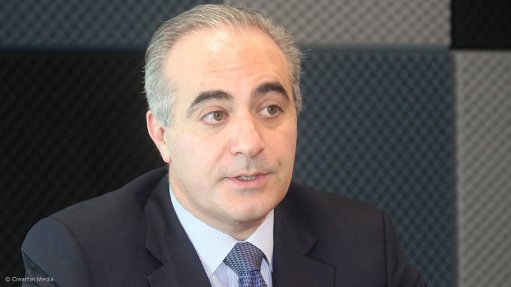
Renergen CEO Stefano Marani
Photo by: Creamer Media's Darlene Creamer
Emerging liquid helium and liquid natural gas (LNG) producer Renergen’s recent listing on the ASX will benefit the company by giving it access to Australian research and industry understanding, CEO Stefano Marani tells Engineering News Online.
Renergen, which is also listed on the JSE’s AltX, provides investors with a unique exposure to helium, which is considered a rare and finite commodity with strong supply and demand fundamentals.
With a market capitalisation of between R1-billion and R1.2-billion, Marani explains that, on the ASX, Renergen is considered a “midcap” and will, therefore, have a lot more liquidity in Australia, where the oil and gas industry is said to “be a bit better understood”.
Renergen raised A$10-million in its secondary listing on the ASX through the issue of 12.5-million shares at A$0.80 apiece, which is twice the minimum subscription.
On its first day of listing on the ASX on June 6, Renergen had more than 290 000 shares traded, at an official listing price of A$0.80 apiece. The price trade increased to A$1.02 at the close, or up 27% from the listing price.
Commenting on the oversubscription achievement, Marani tells Engineering News Online that he believes this is owing to the company’s Virginia gas project, in South Africa’s Free State province, being the first onshore licensed production right in the country.
Renergen owns 90% of Tetra4 Proprietary, which holds the production right in South Africa.
The Virginia gas project spans 187 000 ha of gasfields across Welkom, Virginia and Theunissen.
Additionally, following recent developments, Marani says the project is now close to production, with all the necessary permitting in place.
“From a strategic point of view, just given the strategic importance of helium as a commodity, it becomes a particularly interesting project – especially when you consider how few companies in the world will give an investor exposure to helium,” he elaborates, highlighting that this could be the motivation behind the oversubscription.
Moreover, funds raised under the ASX initial public offering (IPO) will be used for further exploration and expansion of the Virginia project. This is in addition to the $40-million in debt funding that Renergen secured from US-based development finance institution Overseas Private Investment Corporation.
The Virginia project development currently includes drilling of additional production wells and a feasibility study for the commercialisation of the high-concentration helium reserves contained in the project’s prospective sandstone deposit.
Marani reiterates to Engineering News Online that Renergen has determined that it is feasible for the project to produce between 1 000 kg/d and 1 500 kg/d of helium, which could increase to about 5 000 kg/d, should Renergen have the option of tapping into contingent reserves.
Additionally, Renergen will produce, concurrently, up to 10 000 GJ/d of LNG upon reaching full production. This amount of energy is equivalent to 277 000 ℓ/d of diesel.
Putting it into perspective, Marani explains that global consumption of helium is about 77 t/d of helium and, depending on what Renergen finds in the sandstone deposit, the company may be able to help meet the global demand for helium.
“It really depends on what we discover,” Marani says, explaining that “if [Renergen] stays on the base case scenario, then it would be an interesting amount of helium and it wouldn’t be able to offset global shortages, but it would be enough to assist the global supply”.
However, should the sandstone deposit be what the company believes it is, then the project has the possibility of “seriously denting the shortfall and current supply”, he enthuses.
The sandstone deposit’s figures will be released later this year.
Construction is estimated to begin in the second half of the year.
The project is expected to reach commercial production towards the back-end of the first quarter of 2021, Marani says.
Should production be maintained, the production right has a remaining life span of about 23 years.